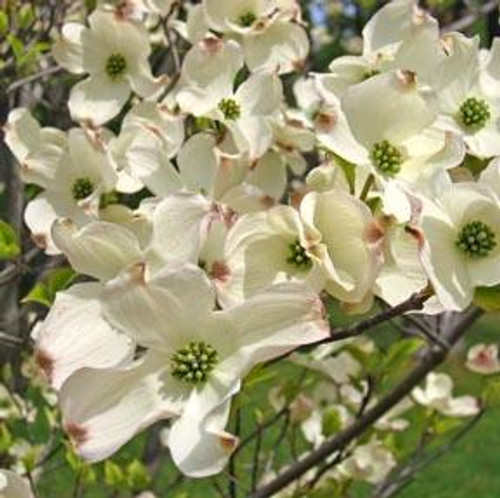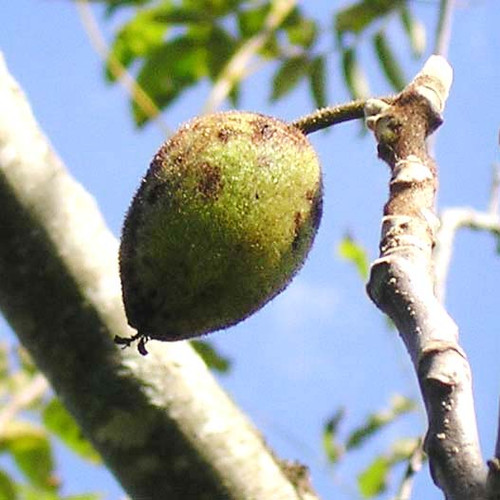Cannot Ship To: AK,HI
Please Read Our Store Policies HERE Before You Order!!
Introduction:
The White Flowering Dogwood Tree (Cornus florida) is a popular deciduous tree known for its stunning white blossoms in the spring and its vibrant red berries in the fall. This ornamental tree is a standout in any landscape, adding beauty and interest year-round. Its broad, spreading form and eye-catching flowers make it an excellent choice for gardens, yards, and borders. The tree’s red berries are a favorite for birds and wildlife, while its fall foliage provides a burst of seasonal color with shades of red and purple.
Plant Summary:
- Size: Grows to a height of 20-30 feet with a spread of 20-30 feet.
- Foliage: Oval-shaped green leaves turn shades of red and purple in the fall.
- Flowers/Fruit: Showy white blossoms in spring, followed by vibrant red berries in fall.
- Growth Habit: Upright with a broad, spreading canopy.
- Sunlight: Prefers partial shade but tolerates full sun in cooler climates.
- Soil: Thrives in moist, well-drained soils but adapts to a variety of soil types.
- Hardiness: Hardy in USDA Zones 5-9.
- pH Level: Prefers slightly acidic to neutral soils (pH 5.5 to 7.0).
- Pruning: Prune in late winter or early spring to remove dead or damaged branches and to shape the tree.
- Pests/Diseases: Generally pest-resistant but may occasionally be affected by dogwood anthracnose or powdery mildew.
Pollination:
The White Flowering Dogwood Tree is self-pollinating, with its showy white flowers attracting bees and other pollinators in the spring. These blossoms give way to bright red berries in the fall, which provide food for birds and wildlife. The tree’s beauty and ecological value make it a favorite for both ornamental and naturalized landscapes.
Key Benefits:
- Showy white flowers in spring add ornamental beauty to your landscape.
- Bright red berries in fall attract birds and wildlife.
- Low-maintenance and adaptable to various soil types and conditions.
- Adds seasonal interest with fall foliage in shades of red and purple.
- Perfect for gardens, borders, or as a standalone specimen tree.
Care Instructions:
- Light: Prefers partial shade for optimal growth and flowering but tolerates full sun in cooler climates.
- Water: Keep soil consistently moist, especially during dry periods.
- Soil Type: Grows best in moist, well-drained soils but adapts to sandy, loamy, or clay soils.
- Pollination: Self-pollinating, with flowers that attract bees and other pollinators.
- Growth Rate: Moderate-growing, reaching maturity in 10-15 years.
- Max Height/Width: Reaches 20-30 feet in height and 20-30 feet in width.
- Pruning: Prune in late winter to shape the tree and remove deadwood.
Why You'll Love It:
The White Flowering Dogwood Tree is a timeless addition to any garden, offering stunning white blooms in spring, vibrant red berries in fall, and rich fall foliage. Its low-maintenance care and adaptability make it a great choice for homeowners looking to add beauty and functionality to their landscape. Whether planted as a specimen tree or part of a larger garden, the White Flowering Dogwood is sure to be a highlight in any yard.
Planting Tips:
Plant your White Flowering Dogwood Tree in early spring or fall in a partially shaded location with well-drained soil. Dig a hole twice as wide as the root system and plant at the same depth it was growing in the nursery. Water thoroughly after planting and mulch around the base to retain moisture. Regular watering during the first few years will help the tree establish a strong root system.
Flower Color:
White
Plant Class:
Deciduous Ornamental Tree
Plant Name:
White Flowering Dogwood Tree
Shipping Details:
Your White Flowering Dogwood Tree will be shipped as a bare root plant, carefully packaged to ensure it arrives in optimal condition. Bare root plants are shipped during dormancy to promote successful transplanting and establishment in your landscape.
13 Reviews Hide Reviews Show Reviews
-
dogwood
packed very well and prompt delivery
-
Good product. No problems
Shipping was good, tree was very well contained to assure root system was well protected and kept moist. Arrived ready for planting.
-
Dogwood tree saplings - perfect!
The two saplings I ordered arrived in great condition. They look perfectly healthy. The low price had me worried, but they look great!
-
Were as expected
I received the trees they were dormant, but alive. They were as expected.
-
Dogwood Trees
Packed and arrived very well. I don’t know if still alive. Pretty brown and crispy. I hope they survive and thrive.
-
I’m very satisfied with my trees.
The Trees arrived 2days ago, I ordered them last spring but I was told that they will be shipped when it was the right time. This company is honest and professional..
-
flowering dogwood tree
Came well packaged and alive, looking forward to spring - also thank you for the free plants you gave me with this order!
-
Awesomeness!!!
Just what I wanted. Packed well and was preserved great!!
-
Lots of branches
I was expecting a stick but instead got a lovely little tree with a nice branching structure and a healthy root structure. Now is just the waiting game. It’s late for bare root in Northern California.









